All About ATL, BTL, And TTL Marketing: Definitions, Activities, And Examples
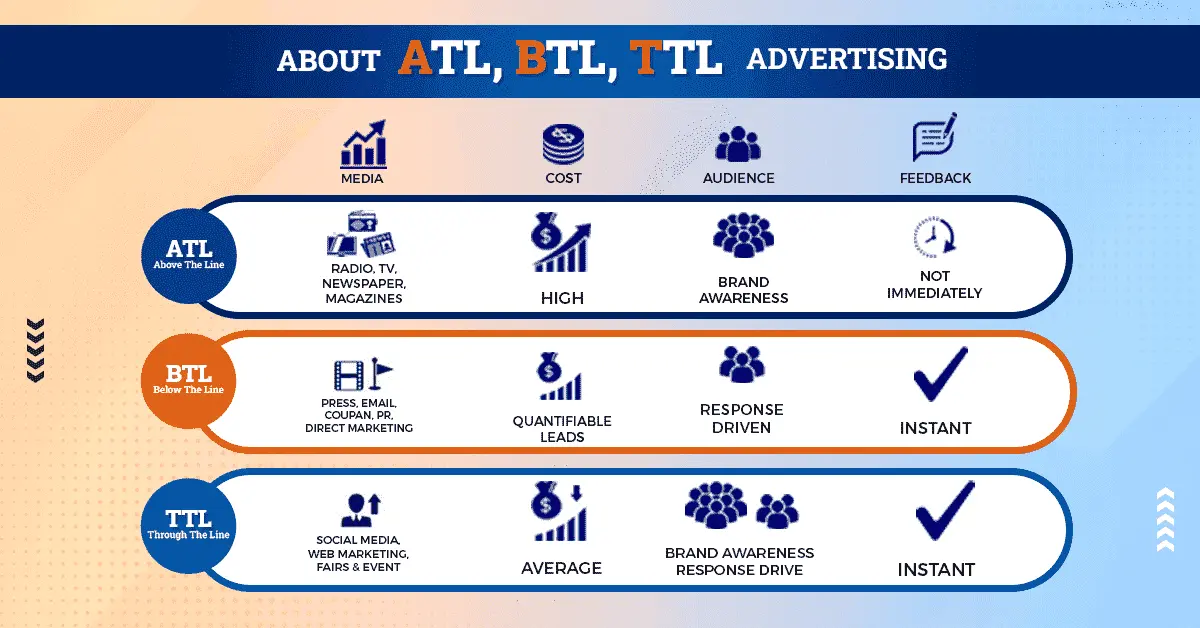
All About ATL, BTL, And TTL Marketing: Definitions, Activities, And Examples
Irrespective of the times we live in, marketing will never go out of fashion. As long as you are creating products/services with utility for your target audience, you would need to employ the best marketing tools and practices to reach out to your customers. For decades, effective marketing has allowed businesses to build their brands and encourage customers to engage with the same.
Marketing is the art and science of getting the traction you have been looking for. When you create a marketing campaign, a lot of factors go into consideration that helps you build the right strategies. One of these factors is the marketing approach you are willing to go for. There are different ways in which you can reach out to your audience – you can address the masses at once, approach a specific bunch of (or individual), or use a combination of both approaches.
This is where you choose between ATL marketing, BTL marketing, and TTL marketing.
Here is a glimpse of the topics discussed in this blog:
- What Is ATL Marketing?
- Examples Of ATL Marketing
- Major Benefits Of ATL Marketing
- Major Drawbacks Of ATL Marketing
- What Is BTL Marketing?
- Examples Of BTL Marketing
- Major Benefits Of BTL Marketing
- Major Drawbacks Of BTL Marketing
- ATL Marketing Vs BTL Marketing: What Should You Choose?
- What Is TTL Marketing?
- Examples Of TTL Marketing
- The Final Word
What Is ATL Marketing?
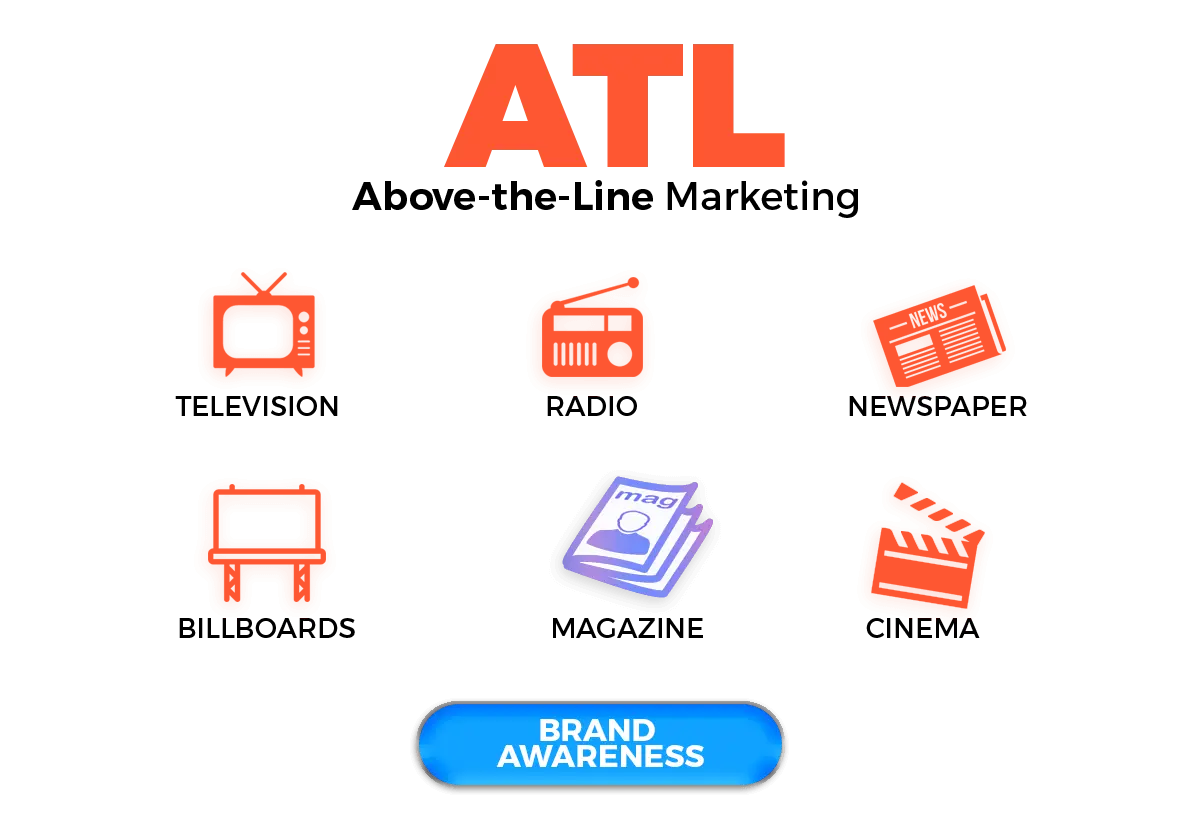
ATL means ‘above the line.’ ATL marketing is the marketing approach that is not targeted to specific individuals or groups of customers. Here, marketers spread their messages to the masses without catering to the needs and preferences of a select few.
ATL marketing is often done on a large scale with the marketers not being in direct contact with their prospects or customers. You can go with this marketing approach if you want to increase the reach of your brand, spread awareness about your brand, and cater to a wider audience.
ATL marketing does not focus a lot on making conversions. The aim of this approach is often to use mass marketing strategies to spread your word among the masses. An ATL campaign focuses more on the media platforms used for carrying the promotional messages of the brands. Anyone having access to the chosen media platforms can be on the receiving end of your ATL marketing messages.
Examples Of ATL Marketing
Search Engine Optimization (SEO)
In the age of digitization, it is important for businesses to make their presence felt on the internet. SEO allows the website of your company to be listed high on the search engine results pages (SERPs). Most businesses operating across multiple industries have been seeking professional SEO services to increase brand awareness and visibility on digital platforms.
A competent SEO company would help you climb up the SERPs by making necessary changes to your website (on-page SEO) and building links to attract more traffic to your site (off-page SEO). With billions of searches being made on Google every day, SEO allows your brand to stand out from the cutter, making it an integral part of your ATL campaign.
Social Media Optimization (SMO)
Another important and highly relevant example of ATL marketing is social media optimization (SMO). With more and more people getting on the bandwagon of social media, brands have started focusing on improving their digital presence on these platforms. By creating official accounts on suitable social media platforms, brands can spread their messages and reach out to their audience effectively.
Targeted SMO services help you optimize your ATL campaign by building a base of prospects and customers in the form of followers. If you are consistent in creating and posting content that is relevant on social media platforms, you can make more people aware of your brand and get more digital traction.
Public Relations
Public relations allow you to spread the word about your brand to the public in an organic way. Whether you want to make an important announcement regarding your business, make the public aware of your new offerings, or simply rekindle the image of your brand in the market, a PR campaign helps you get the work done without pushing your promotional messages.
For example, if you own an IT company and want your prospects in India to know about the use of new technologies by your business, you can reach out to a PR agency in India to craft an engaging PR article/press release. This would allow leading media houses in the country to cover your story, helping you get your message across in an organic and credible manner.
Along with being an important ATL marketing example, PR also allows you to build fruitful media relations, manage crises, and build the reputation of your brand in the industry you operate in.
Television And Print Ads
Over decades, advertising has remained one of the most widely implemented ATL marketing activities. It allows several brands across the globe to reach out to their audience through a myriad of different platforms. Despite being replaced by digital alternatives rapidly, television and print ads still help brands get a lot of traction across the board.
Even in the age of Google and YouTube banner ads, it is a matter of prestige for a brand to get a spot during Superbowl breaks or be featured in a leading magazine.
Outdoor Advertising
This is the space where brands can get really creative! Outdoor advertising allows marketers to grab the attention of their audience by being as minimalistic as possible. Essentially, this is because people looking at billboards and hoardings do not have enough time to read long texts.
If utilized well, outdoor advertising can be a really fruitful example of ATL marketing. It helps you increase the recall value of your brand, even if the prospects do not end up engaging with your business right away.
Major Benefits Of ATL Marketing
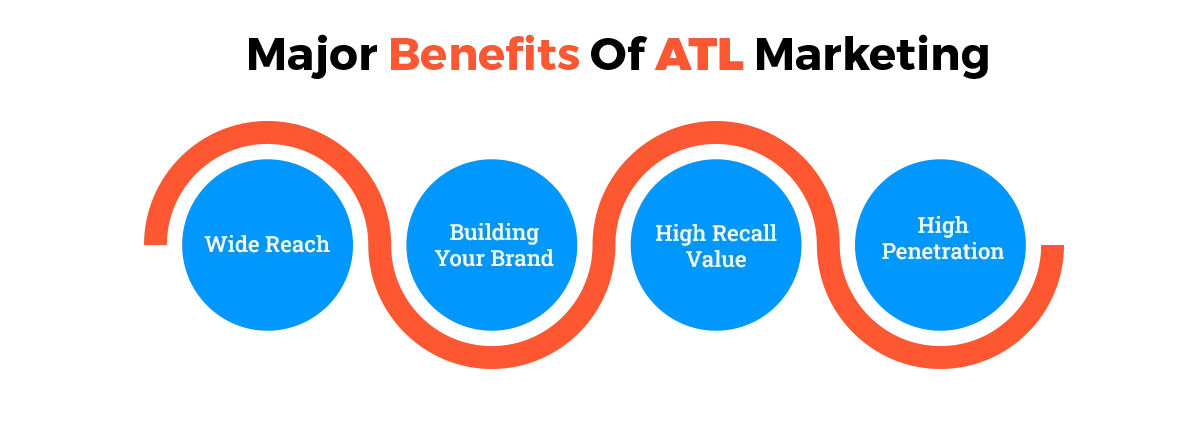
Wide Reach
The biggest benefit of ATL marketing is the reach it provides to your brand. It allows you to use mass marketing strategies to cover a large spectrum of audiences who can consume your promotional messages. As the focus of an ATL campaign is not to facilitate the immediate conversion, it allows you to make a lot of people aware of your brand. This often helps existing brands reinstate their image and allows new brands to increase awareness in the market.
Building Your Brand
We live in an age where competition is intense across all major industries. If you want to stand out from the clutter, it is important to build a strong brand with a unique personality. ATL marketing allows you to circulate creative promotional messages amongst your audience, helping you build your brand successfully. Especially if you are entering the market with a new brand, ATL marketing is an ideal approach to get your promotional messages across in the best way possible.
High Recall Value
Thanks to the media platforms used for ATL marketing, you can create ads and craft promotional messages that increase the recall value of your brand. It is effective ATL marketing campaigns that have helped brands like Coca Cola, McDonald’s, Nike, imprint their images in the minds of their audience through their ads. Even if your prospects do not end up buying your offerings immediately, your brand will linger in their heads for a long time after consuming your messages.
High Penetration
Media platforms like television, newspapers and the internet have the power to reach the remotest corners of the world and make your prospects aware of your brand. As there is no need to engage with your audience directly, ATL marketing helps you carry your messages everywhere the chosen media platform can reach.
Major Drawbacks Of ATL Marketing
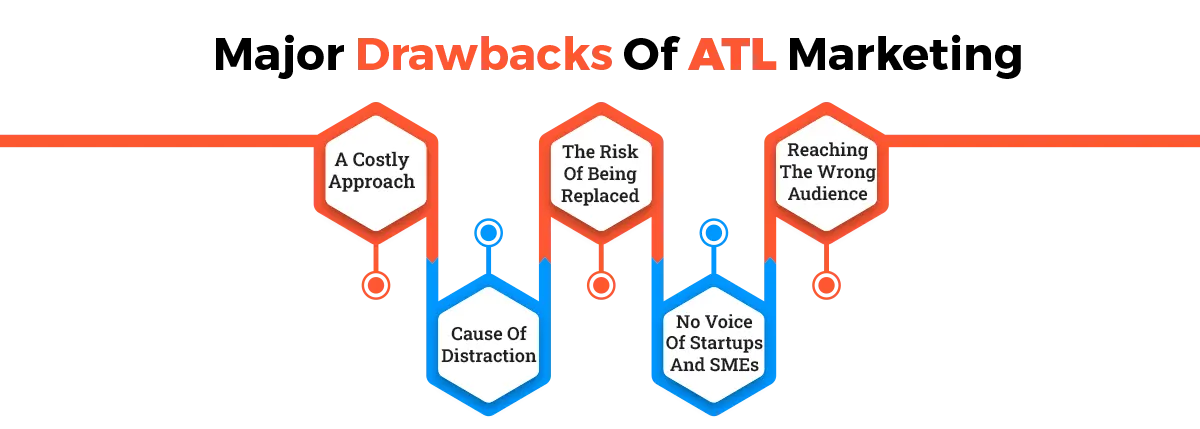
A Costly Approach
As ATL makes use of mass marketing strategies, it leads to brands spending a fortune for reaching out to their audience. Media platforms like television, newspapers, and magazines are fairly expensive when it comes to getting your ads published/broadcasted. If you are planning to create an ATL campaign for your brand, make sure your budget allows you to use the chosen media platforms effectively.
Cause Of Distraction
Especially in the case of outdoor advertising, hoardings and billboards often tend to distract people driving on the road. While creative ad copies are highly engaging, using them for outdoor advertising may lead to unforeseen accidents on the road.
The Risk Of Being Replaced
Media platforms like television, newspapers, and magazines are quickly being replaced by digital alternatives that can be accessed at a much lesser price. As digitization is getting increasingly prevalent, customers across the board are drifting away from conventional media platforms. This reduces the longevity of these platforms being used for ATL marketing campaigns.
No Voice Of Startups And SMEs
As most platforms used for ATL marketing are expensive, they often don’t allow startups and SMEs to use them for reaching out to their audience. This makes the market more exclusive by keeping a large chunk of deserving businesses out of the scene.
Reaching The Wrong Audience
With ATL marketing, you do not have control over the people consuming your ads and promotional messages. While this marketing approach helps you reach out to the masses, it is likely that a large chunk of the recipients does not belong to your target audience. This makes you lose the impact of your ATL campaign, irrespective of how well-crafted it is.
ATL Real Life Marketing Examples
What Is BTL Marketing?
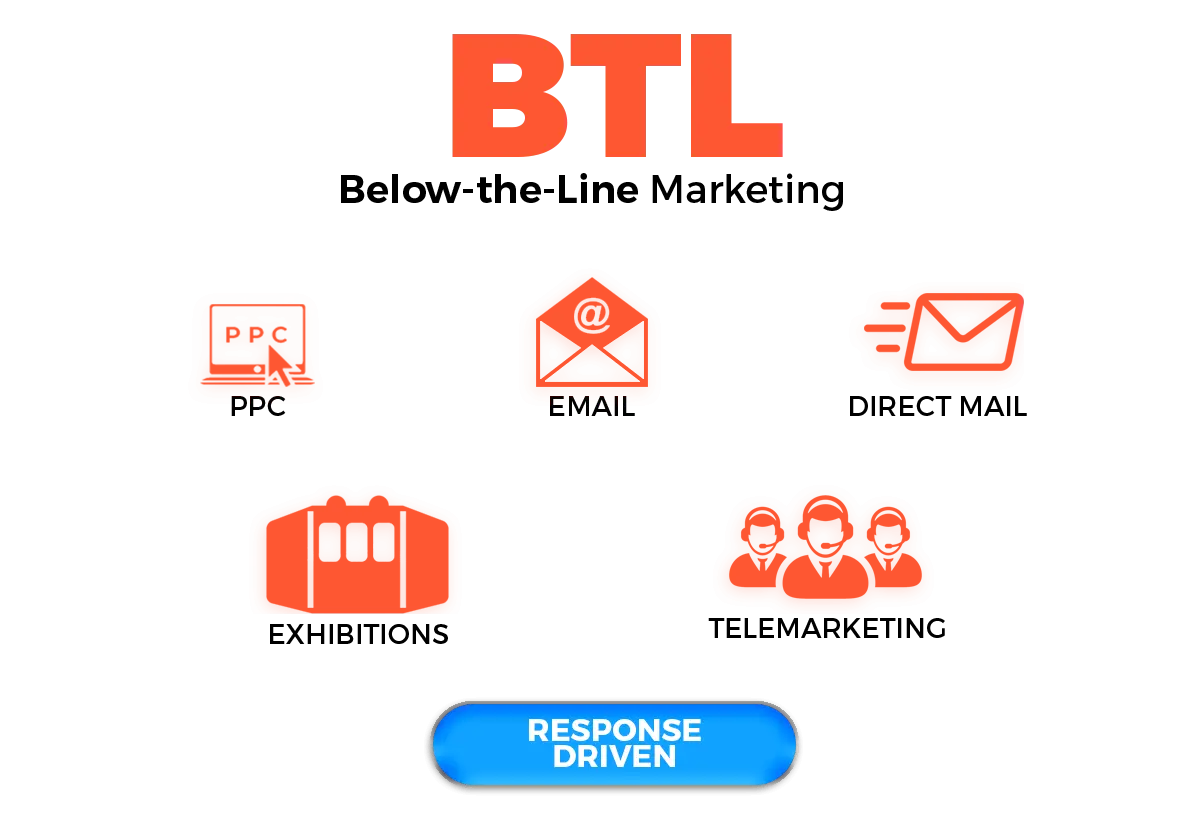
The BTL full form stands for ‘below the line.’ As opposed to ATL marketing, this marketing approach involves targeting an individual or a group of prospects/customers for circulating promotional messages. BTL marketing is all about engaging your customers in a more personalized manner. It involves assessing the specific needs and preferences of your target audience and tailoring your marketing campaigns based on the same.
In the case of BTL activities, the focus is on making conversions instead of spreading awareness about the brand. Most businesses charting out a BTL marketing campaign have already built their brands with their audience being aware of their existence. This marketing approach revolves around persuading the audience to make the purchase and driving revenue home. In other words, BTL marketing is a more sales-oriented approach.
Examples Of BTL Marketing
Sales Promotion
Sales promotion is a set of marketing strategies that revolve around attracting customers and boosting sales for a short period of time. The purpose of sales promotion is to drive more revenue home by providing exciting offers and discounts to the customers.
Sales promotion is one of the most commonly used BTL activities. It involves persuading prospects and customers by providing them with incentives like free trials, free coupons, samples, personalized discounts, and more.
Although sales promotion reduces the profit margin for your business, it allows more people to use the products/services of your brand who wouldn’t have done so otherwise. If your offerings are genuinely good and strike a chord with your customers, they would continue engaging with your business even after your sales promotion campaign is over.
Direct Marketing
As the name suggests, direct marketing is a BTL marketing technique where the marketer engages directly with a prospect or a customer. Earlier, direct marketing involves sales reps physically visiting the houses of their existing and potential customers to sell them the offerings of their brands. With the advent of digitization, direct marketing has moved on to digital platforms.
Whenever an individual makes a purchase, the details of the same are recorded with the seller, ideally on their CRM (customer relation management) platform. These details are then used to approach the concerned customer across multiple channels, asking them to have a look at similar products or make another purchase of the same offering.
One of the best and the most effective examples of direct marketing is Amazon recommending products to users based on their previous purchases. Such BTL marketing techniques personalize the services offered by brands, making their customers feel special.
Email Marketing
Most brands indulge in the creation of personalized promotional emails to persuade their prospects and customers for making purchases. Right from giving exclusive offers to asking the customers to opt for online newsletters, email marketing allows you to reach out to each of your customers based on their history of purchases, needs, and preferences.
However, it is advisable to get your customers’ consent before sending them promotional content related to your brand. If they have given you their consent, make sure you provide them with the option to opt out at their convenience.
Sponsorships
Brands often decide to sponsor specific events to reach out to their target audience. Here, businesses attach their names with the events where they are promoted and talked about by the organizers. If the audience attending a specific event is your target audience, you can reach out to them and persuade them to check out your offerings through the concerned event. Based on the credibility of the event, this BTL marketing technique would give you the traction you are looking for.
Brand Activation
Brand activation refers to a set of activities that allow your audiences to interact with your business and experience your offerings. This BTL marketing example is generally implemented by new and growing businesses. Here, you can get as creative as possible to get the desired traction from your customers.
There are different ways in which you can go use brand activation to increase your ROI and drive more revenue home. You can set up a physical storefront and make your customers try your offerings before they buy them. If you are willing to make the most of the modern technologies, you can use AR to provide an immersive experience to your prospects and customers, making them aware of your brand and its offerings.
Exhibitions And Trade Fairs
This is one of the most cost-effective ways of optimizing BTL marketing for your brand. Several businesses prefer to be a part of trade fairs and exhibitions where they can expect a good number of visitors. Once you are a part of such events, you can attract prospects by being creative and optimizing your kiosk.
Major Benefits Of BTL Marketing
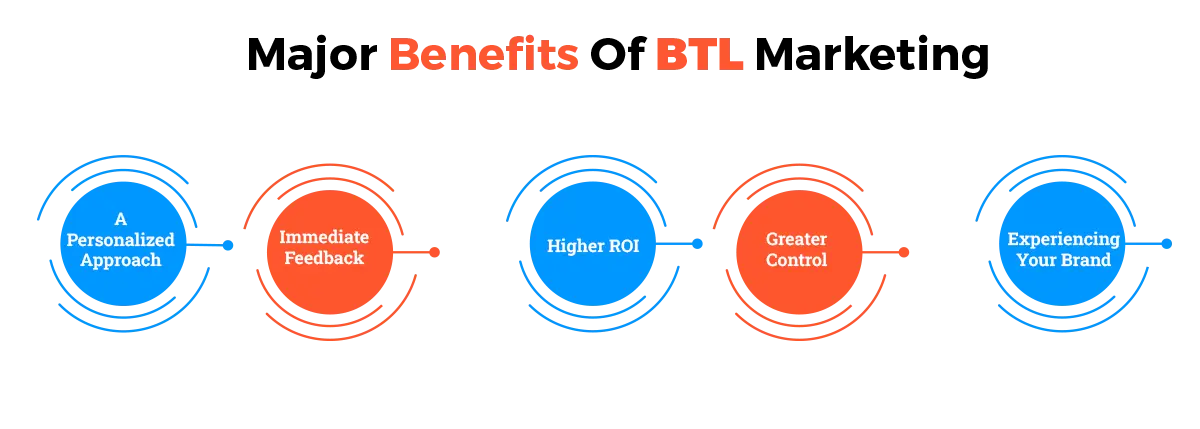
A Personalized Approach
In the case of ATL marketing, it is not possible to create a TV or newspaper ad that is different for every reader. On the other hand, BTL marketing allows you to personalize your marketing processes for every customer you cater to. Whether you choose to do so physically (exhibitions and trade fairs) or by using a dedicated software platform (email marketing), you can rest assured that every customer is treated in a unique way.
The personalized approach of BTL marketing allows you to build long and healthy relationships with your customers.
Immediate Feedback
Most BTL marketing techniques allow you to obtain immediate feedback. When you directly interact with a customer or a prospect, you often tend to get a ‘yes’ or a ‘no’ without any delays. Even if the prospect is not sure willing to make a purchase at the moment, you can always have their details recorded in your CRM to be used later. Such immediate feedback reduces the time your sales reps spend while nurturing your leads.
Higher ROI
A major difference between ATL and BTL marketing is the focus on making conversions. As BTL marketing is all about closing deals, it provides you with a better ROI as compared to an ATL marketing campaign. Also, the cost involves in BTL marketing activities is fairly less, further increasing the profits you make on every sale. If your intention is to make more money by combining marketing and sales, you should certainly go the BTL marketing way.
Greater Control
In the case of a BTL marketing campaign, you have greater control over the audience consuming your promotional messages and the services you are willing to provide. This allows you to tailor your processes based on different prospects and customers you encounter. BTL marketing also allows you to easily keep track of your marketing processes and the ROI you receive out of the same.
Experiencing Your Brand
One of the biggest reasons why BTL marketing is successful in making conversions is
that it allows you to make your customers experience your brand. Whether you provide
them with free/discounted samples of your products or allow a free trial before
purchase, your customers get to have a first0hand experience in consuming your
offerings. This allows you to establish a better and more personal connection with
your customers.
Major Drawbacks Of BTL Marketing
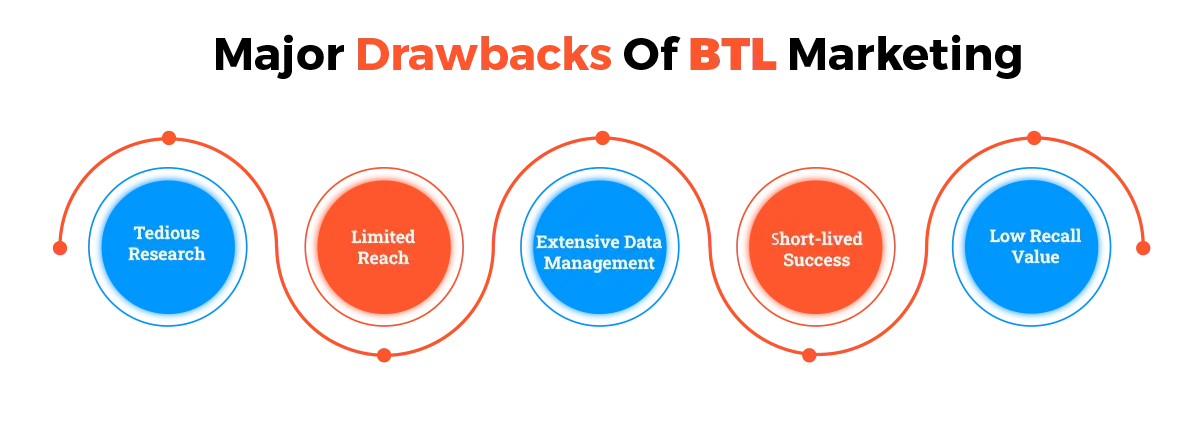
Tedious Research
While implementing most BTL marketing activities, there is a need to undertake thorough and tedious research – much more than the research required for ATL marketing. Brands may need to hire specialized resources and spend a lot of time before they actually approach their prospects and customers.
Limited Reach
While BTL marketing is effective in targeting a specific bunch of audiences, it limits the reach you can achieve with your marketing practices. If you want more people to be aware of your brand and establish its presence on a large scale, BTL marketing may not be the best alternative to go for.
Extensive Data Management
The core of BTL marketing is data management. In order to provide personalized services to your customers, brands need to record every action performed by them and the specific needs and preferences of their customers. For organizations that are not equipped with adequate resources, extensive data management can get complicated and tedious.
Short-lived Success
If you come up with exclusive offers and deal for your customers to drive more conversions, your success is likely to be short-lived. When you implement BTL marketing, you always stand the risk of your customers discontinuing engagement when you stop giving them offers.
Low Recall Value
With immense competition in the market, several brands offer short-term incentives to their customers to boost their sales. This may persuade the audience to engage with a brand purely based on the incentives offered. In most cases, this does not go down well with maintaining the image and recall value of a brand.
ATL Marketing Vs BTL Marketing: What Should You Choose?
It is a common dilemma for brands to choose between ATL and BTL marketing while creating their marketing campaigns. When it comes to ATL vs BTL marketing, there is no objective answer. The marketing approach you should choose depends on a lot of different factors, some of which are discussed below:
Marketing Objective
At the end of the day, every marketing decision you make revolves around the objective you want to achieve. If your marketing objective is to make your audience aware of your brand and reach out to a wider audience, you should go for ATL marketing. On the other hand, if you aim at boosting your sales and earning more revenue, BTL marketing is the right choice.
Marketing Budget
Brands often spend a fortune on their marketing campaigns. If you are ready to spend a good amount of money for reaching out to your audience and can afford expensive campaigns, you can make the most of ATL marketing techniques. On the other hand, if your budget is tight and you are not willing to spend a lot on marketing, you can go with BTL marketing.
Preferred Media Platforms
The media platforms you prefer also dictate your marketing approach. Essentially, this depends on the platforms used frequently by your target audience. If you want to target your customers via expensive mass media platforms like television, newspapers, and magazines, you should plan on creating an ATL marketing campaign. On the other hand, you want a more intimate campaign that used platforms like email, mobile, and web, you can choose a suitable BTL marketing technique.
BTL Real Life Marketing Examples
What Is TTL Marketing?

TTL stands for ‘through the line.’ This is the marketing approach that combines the ATL and BTL marketing techniques. TTL marketing is a more holistic way of reaching out to your audience and persuading them to purchase your offerings.
This approach provides marketers with the best of both worlds. While it allows brands to reach out to a wide range of audiences, it does not lose focus from making conversions. TTL marketing is a fairly new approach that is thriving in the age of digitization. It facilitates mass engagement by circulating promotional messages on a large scale and driving engagement on an individual level.
To implement a holistic TTL marketing campaign, brands often use conventional media platforms like TV, radio, newspapers, magazines, etc. for reaching out to the masses and make them aware of their businesses. Once they are successful in creating brand awareness, they engage with the prospects and customers on a personalized level through targeted marketing (especially on digital platforms).
This combination of ATL and BTL marketing allows brands to leave no stone unturned in making their presence felt in a highly competitive market and generating the ROI they desire.
Examples Of TTL Marketing
360-degree Marketing
As the name suggests, 369-degree marketing is a comprehensive and holistic way of marketing your offerings. It follows generic and targeted approaches at different levels.
Especially in the case of bigger brands with greater resources, they choose to engage their audiences using multiple platforms. While you see a McDonald’s ad on TV, you also get personalized emails and text messages from the brand. This way, you can have complete control over the channels you want to use and the manner in which you want to approach your audience.
However, it is important to note that 360-degree marketing is not limited to high-end enterprises. By using cost-effective media platforms, startups and SMEs can also make their presence felt and create their niche in the market with a good TTL marketing campaign.
Digital Marketing
Digital marketing is an ideal example of a TTL marketing technique as it encapsulates the essence of ATL and BTL approaches. While a banner ad on Google can reach out to millions of prospects, email marketing with a smart call-to-action allows you to personalize your marketing processes.
Right from SEO and SMO to content marketing and PPC advertising, every tool of digital marketing can be considered a really good example of TTL marketing. As the need for digitization keeps increasing steadily, it is safe to say that TTL marketing via digital platforms is here to stay. In the days to come, more and more brands are likely to make the much-needed shift to digital marketing as it offers them the benefits of ATL (wide reach, recall value, brand awareness, etc.) and BTL (cost-efficiency, personalization, immediate feedback, etc.) marketing.
Digital PR
While conventional public relations are largely a part of ATL marketing, digital PR is an efficient TTL marketing technique. Over the last few years, this new-age approach to PR has gained momentum, allowing brands to spread organic promotional messages across multiple digital platforms.
As the name suggests, digital PR consists of PR activities performed via digital platforms. It involves the creation and publication of online press releases and PR articles. As every leading media house across the world, today has a digital presence, digital PR helps brands reach out to the public via digital platforms.
Brands also collaborate with content marketing experts and bloggers to share their stores on suitable platforms online. This is a very effective way of combing the essence of ATL and BTL marketing. As the online PR articles are in the public domain, they can be accessed by anyone having the links or stumbling upon the articles while browsing. Moreover, these articles contain links to the websites/applications of the businesses being promoted, leading to a more personalized approach to marketing.
In addition to the benefits offered by digital PR in the realm of organic marketing, it can be clubbed with other digital marketing tools to improve the traction received. For example, the PR articles published online can be indexed higher on Google with the help of SEO. Sharing these articles on social media platforms helps you optimize SMO. This is where digital PR has an edge over conventional PR.
TTL Real Life Marketing Examples
ATL, BTL & TTL – Community Insight
While there are many academic definitions of ATL, BTL, and TTL marketing, one Reddit user broke it down in a very practical and easy-to-understand way — based on how these terms came to be used in the real world.
According to a community discussion on Reddit, the terms ATL and BTL date back to 1954, when Procter & Gamble started paying different advertising agencies separately — one for broad campaigns (like TV and print) and another for direct marketing activities (like events and door-to-door promotions). This led to the natural split between ATL (Above The Line) and BTL (Below The Line) strategies.
The concept of TTL (Through The Line) came later, representing a more integrated marketing approach — where both ATL and BTL techniques are used together to build brand and drive direct response.
Here’s how the user summarized it:
- ATL Marketing is for mass reach and brand awareness (e.g., TV ads, radio).
- BTL Marketing targets specific audiences (e.g., Google Ads, telemarketing).
- TTL Marketing combines both — for example, a YouTube ad campaign offering local promo codes to drive nearby purchases.
The Final Word
This is all you should know about ATL, BTL, and TTL marketing to get yourself introduced to the marketing approaches. However, this is just the tip of the iceberg! If you want to ace your marketing campaigns and build a loyal base of customers, it is important to select the most suitable approach to marketing and go for a deep dive into the same.
FAQs
- What is ATL marketing?
- What is BTL marketing?
- What is TTL marketing?
- What are the key differences between ATL, BTL, and TTL marketing?
- How do ATL, BTL, and TTL marketing strategies differ in cost?
- Which businesses benefit most from ATL marketing?
- When is BTL marketing the most effective choice?
- Can a business use a combination of ATL, BTL, and TTL marketing?
- How do ATL, BTL, and TTL marketing impact consumer engagement?
- What are some successful ATL, BTL, and TTL marketing campaigns?
ATL marketing, or Above-the-line marketing, is a strategy to reach a mass audience through mass media channels. This approach employs various platforms like television, radio, billboards, and print media to convey a message to a broad and diverse audience.
BTL marketing, also known as Below The Line marketing, targets specific consumer groups. It involves personal interactions and engagement through direct mail, email marketing, trade shows, and social media campaigns.
TTL marketing, or Through The Line marketing, combines ATL and BTL strategies. It is designed to create a seamless and comprehensive marketing experience for consumers. TTL marketing integrates mass communication channels with targeted, personalized efforts to engage consumers on various levels.
The primary differences lie in the audience reach and level of personalization. ATL marketing is broad and reaches a large, diverse audience, while BTL marketing is highly personalized, targeting specific consumer segments. TTL marketing strikes a balance, creating a harmonious blend of mass communication and personal engagement.
ATL marketing tends to be more expensive due to high-cost media channels. BTL marketing may be more cost-effective since it targets specific demographics. TTL marketing falls in between, with a flexible cost structure that depends on the extent of integration.
Large corporations with broad target markets often benefit from ATL marketing. It is particularly effective for brand building and increasing brand awareness.
BTL marketing shines when you need to connect with a highly specific audience, promote niche products, or conduct localized marketing campaigns.
Absolutely! Many successful marketing campaigns combine all three approaches to create a comprehensive strategy that covers all bases.
ATL marketing creates awareness, BTL marketing fosters deeper engagement, and TTL marketing ensures a holistic brand experience, which can lead to long-term customer loyalty.
ATL: Coca-Cola's global "Open Happiness" campaign.
BTL: Red Bull's extreme sports events and sponsorships.
TTL: Apple's product launches, combining TV ads and in-store experiences.

Blog Admin:
Ravinder Bharti
CEO & Founder - Public Media Solution
About: Ravinder Bharti is the Founder and CEO of Public Media Solution,
a leading
marketing, PR, and branding company based in India.










